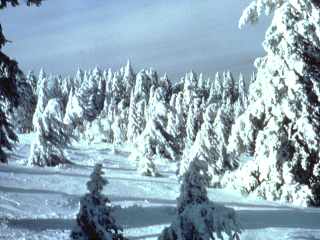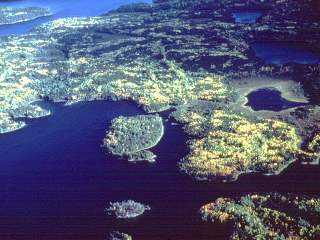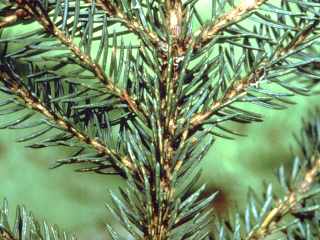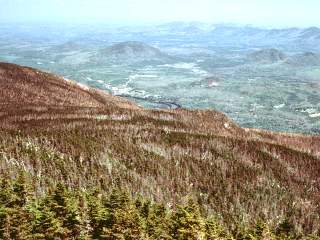The Northern Coniferous ForestThe northern coniferous forest of the Subarctic climate, also known as the boreal forest, is dominated by coniferous trees, with hardy deciduous trees like birch mixed in. To the south lies the temperate forest and the north the tundra. An ecotone found between northern coniferous forest and tundra vegetation called the taiga. Taiga is a more open form of boreal forest with low growing conifers. Historically, the pine forests of North America and Europe have been an important timber resource. Trees are typically shallow rooted due to the poor soils (spodosols), rocky conditions, discontinuous permafrost.
Figure 13.12 Snow covered conifers of the Northern Coniferous forest. (Source: Tom Smylie U.S. Forest Service) Coniferous forests (taiga) circles the globe and contains a third of all the trees on earth. On its northern edge the growing season is a mere one month long. It's a silent world, lacking many animal species as there is little palatable food, the resinous conifer leaves make them quite distasteful to most animals. Food for larger animals is sparse in such an ecosystem and they are likely found where wind throw or fire has created openings in the forest for deciduous shrubs such as birch, aspen and willow to invade colonize. Trees in the northern coniferous forest primarily possess pine
needles instead of broad leaves like those of the temperate forests to the south. Being
dark in color they absorb what little light falls on their surfaces. Retaining their needles at the end of each growing season gives
the tree a head start at
growth during the spring as they do not have to waste their energy in producing new
foliage.
The
sloping sides of the conical canopy helps catch the low angle sun rays typical of high latitude locations.
Usually there is only one tree layer creating a shading effect that precludes the growth
of any lower tree layers.
Figure 13.12 Birch intermixes with spruce in an open canopied Northern Coniferous forest. (Source:H. Peter Wingle U.S. Forest Service) Conifers possess a shallow, extensive, yet compact, network of roots. Waxy, resinous needles and low bacterial activity in the cold subarctic climate combine to produce a thick mat of undecayed litter on the forest floor. Soils (spodosols) are poor and acidic since few nutrients are released into the soil. Filamitous fungi surrounding the root ball extend hairs into the needles lying at the surface, breaking them down into substances usable by the trees.
Much of the northern coniferous forest of Europe and the eastern United States has suffered from the affects of acid deposition. Acid deposition refers to the depositing of acids in both solid and liquid form. The most common form of acid deposition is acid rain. Much of the source of sulfur is from industrial activities. Acid rain forms when sulfur compounds combine with water in the atmosphere to form sulfuric acid. Acid rain can severely damage the structure of pine needles making them vulnerable to invasion by other diseases and organisms. Soils in which the plants grow are acidified, mobilizing soluble metals in the soil water and proving toxic to plant roots.
Figure 13.15 Acid damaged forest in the northeastern
United States For many years, scientists suspected that acid rain could damage forest ecosystems. It wasn't until relatively recently that they have for direct evidence to support their suspicions. Find out how in this All Things Considered (NPR) segment from October 28, 1999 about scientist's direct link between forest degradation and acid rain. (3:49) Assess your basic understanding of the preceding material by "Looking Back at Patterns of the Biosphere and the Forest Biome" or continue reading.
|


 Figure 13.14 Close-up of spruce needles
damaged by acid rain
Figure 13.14 Close-up of spruce needles
damaged by acid rain